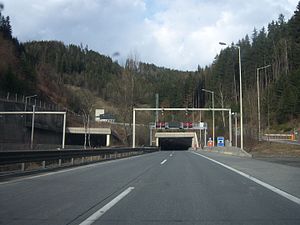Tanzenberg tunnel
| Tanzenberg tunnel | ||
|---|---|---|
|
Tanzenberg tunnel south portal
|
||
| use | Road tunnel | |
| traffic connection | Semmering expressway | |
| place | Bruck an der Mur / Kapfenberg | |
| length | 2.5 km | |
| vehicles per day | approx. 26,000 vehicles / day | |
| Number of tubes | 2 | |
| cross-section | Highway | |
| construction | ||
| Client | ÖSAG | |
| completion | 1st tube 1983, 2nd tube 1985 | |
| planner | ÖSAG | |
| business | ||
| operator | ASFINAG | |
| toll | Vignette requirement | |
| location | ||
|
|
||
| Coordinates | ||
| North portal | 47 ° 26 ′ 47 ″ N , 15 ° 19 ′ 6 ″ E | |
| South portal | 47 ° 25 ′ 35 ″ N , 15 ° 18 ′ 8 ″ E | |
| Emergency exit | 47 ° 26 ′ 26 " N , 15 ° 18 ′ 43" E | |
The Tanzenberg tunnel is a two-tube tunnel on the Semmering expressway S6 in Austria and the easternmost part of the Bruck tunnel chain . He crosses the 681 m above sea level. A. Hohen Tanzenberg, is located south of Kapfenberg and the Mürz .
Its construction was necessary in order to realize a bypass for vehicles from the neighboring towns of Kapfenberg and Bruck an der Mur near the densely built-up narrow Mürz Valley . Kapfenberg is connected with Exit 73 of the S6 in the east, after 500 m the 2.5 km long tunneling of the Tanzenberg follows and also in the south-west the use of the terrain furrow of the Kaltbach to about 2.5 km above ground (last stilted) to follow a total of 5.5 km to connect Bruck by means of the north end of the S35 .
The north tube, which is 2502 m long and brings traffic in the direction of Bruck / Mur, was put into operation on November 14, 1983. At that time it still had a false ceiling and was designed with semi-cross ventilation. In the course of the last renovation, this ceiling was removed and longitudinal ventilation was created. The 2,519 m long south tube (traffic in the direction of Vienna) went into operation on June 30, 1985 and was already equipped with longitudinal ventilation at that time.
In 2001, an average of 20,800 vehicles passed the tunnel per day, 12% of them trucks . In the meantime this number has increased to approx. 26,500 vehicles with a truck share of around 13%. For the year 2025, a traffic forecast is now based on around 34,000 vehicles, around 15% of which are trucks.
Due to the outdated tunnel safety technology and the continuously increasing volume of traffic, the Tanzenberg tunnel was opened from October 22, 2007 to April 2, 2009 (opening for full operation at 5 p.m.) by ARGE Tanzenberg tunnel (consisting of ÖSTU-Stettin , Junge and Hereschwerke) on behalf of Asfinag subjected to a general renovation. The outdated tunnel technology was completely overhauled and adapted to the current guidelines for tunnel safety in the RVS . The costs of the renovation amounted to around 40 million euros. The next renovation project of the Bruck tunnel chain was the Massenberg Tunnel between Leoben West and East, which was completely overhauled from 2009 to 2010. Other projects on the Bruck tunnel chain are the tunnel and the underpasses Bruck, St. Ruprecht, Oberaich and Niklasdorf. Overall, the total costs for these projects amount to around 90 million euros.
Since the beginning of May 2019, the entire interior route lighting has been converted to energy-saving and brighter LED lighting.
In a press release on July 29, 2010, Asfinag announced that the Tanzenberg tunnel was rated “very good” in the European tunnel test and thus, together with the Katschberg tunnel , is one of the safest in Europe.
Four drivable “cross passages” connect the two tubes with a center distance of 25 to around 120 m for emergencies. Both tubes together have 4 storage niches, as well as a further 22 emergency call and 46 fire extinguishing niches. The tunnel is monitored by the also newly built monitoring center in Bruck / Mur.
swell
- ASFiNAG
- Helga Papst: Kapfenberg , Stadtgemeinde Kapfenberg - Referat für Kultur, Kapfenberg 1999, ISBN 3-9501065-1-0 , p. 184
- ASFINAG: Katschberg and Tanzenberg tunnels among the safest tunnels in Europe , July 29, 2010, accessed on August 6, 2014
Individual evidence
- ↑ ASFINAG: Katschberg and Tanzenberg tunnels among the safest tunnels in Europe , July 29, 2010, accessed on August 6, 2014

